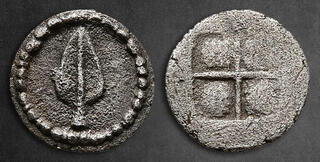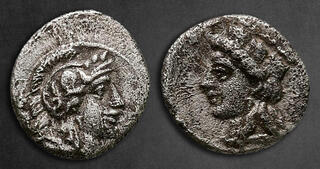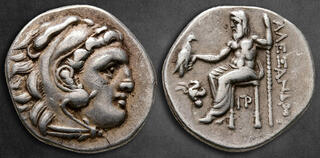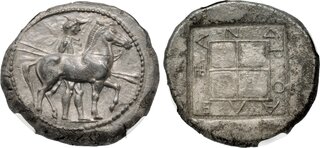Match 1:
Match 2:
| Leu Numismatik AG > Auction 15 | Auction date: 1 June 2024 |
| Lot number: 60 Price realized: This lot is for sale in an upcoming auction - Bid on this lot  | |
| Lot description: KINGS OF MACEDON. Demetrios I Poliorketes, 306-283 BC. Stater (Gold, 18 mm, 8.64 g, 5 h), in the types of Alexander III. Amphipolis, circa 294-293. Head of Athena to right, wearing Corinthian helmet decorated with a double coiled serpent. Rev. ΔHMHTPIOY - BAΣIΛΕΩΣ Nike standing front, head to left, with her wings spread, holding laurel wreath in her right hand and stylis in her left; to lower left, Z; to lower right, monogram. HGC 3, 1006d. Newell -, cf. 93 (unlisted combination of dies S/cc). Extremely rare and among the finest known examples. Beautifully struck and with a fine head of Athena. A few very light scratches and edge marks, otherwise, extremely fine. Ex Elsen 51, 13 September 1997, 168. Demetrios I Poliorketes stands as perhaps the most tragic figure among the Diadochi. As the son of Antigonos I Monophthalmos, he bore witness to his father's ascension to become the most powerful ruler of his time, serving him as a general in numerous major engagements among Alexander's surviving companions. Demetrios achieved his most notable triumph in the naval Battle of Salamis in 306 BC, where he soundly defeated Ptolemy I - a monumental victory that led to his father assuming the royal title. This move spurred Antigonos' adversaries to follow suit, and by the close of 305 BC, there were now four Macedonian kings: Antigonos, Ptolemy, Lysimachos, and Seleukos. In the years 305-304 BC, Demetrios oversaw the famous siege of Rhodes, earning him the epithet Poliorketes ('the Besieger'), though he ultimately failed to conquer the city. The defeat at the Battle of Ipsos in 301 BC dealt a decisive blow to the Antigonid aspirations of ruling the entirety of Alexander's vast empire. Antigonos himself met his end in the debacle, while his son, known for his notorious impetuosity which had greatly contributed to the defeat, narrowly escaped to Ephesos. Despite being outmatched on land, Demetrios asserted naval dominance for several years with his formidable fleet of 300 warships, securing control over many strategic harbor cities and briefly reclaiming Macedon in the late 290s BC. However, his recklessness led to his downfall when he invaded Asia Minor in 287 BC. Pursued by Agathokles, the son of Lysimachos, and Seleukos, Demetrios' forces dwindled rapidly, leading to his surrender to the latter in the early spring of 286 BC. Seleukos accorded the defeated former king, who happened to be his former father-in-law and his son's present father-in-law through Seleukos' marriage to Stratonike, with profound respect. He provided him with his own court and funded his extravagant lifestyle. In confinement, Demetrios, once known for his vigor and energy, succumbed to a life of indulgence and excess. He passed away three years later, at the age of 54, at the culmination of a life marked by rapid ascent and tragic downfall - a remarkable general and esteemed king, whose spectacular rise and fall stirred the emotions and aspirations of contemporaries and posterity alike. Estimate: 10000 CHF | 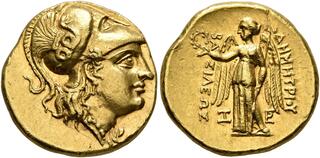 |
Match 3:
Match 4:
| Classical Numismatic Group > Auction 126 | Auction date: 28 May 2024 |
| Lot number: 123 Price realized: This lot is for sale in an upcoming auction - Bid on this lot  | |
| Lot description: KINGS of MACEDON. Alexander I. 498-454 BC. AR Tristater – "Oktadrachm" (30.5mm, 28.43 g). Light Aeginetic standard. Aigai mint. Struck circa 476/5-460 BC. Horseman, wearing chlamys and petasos, and holding two spears, standing right behind horse advancing right / Quadripartite incuse square. Raymond pl. II, 4; AMNG III p. 49, 7 (Bisaltai); HPM pl. XII, 2 (Bisaltai); SNG ANS 1; Athena Fund I 21 (same obv. die); Boston MFA 617 (Bisaltai); Gillet 739; Pozzi 696 = Rhousopoulos 1006 (Bisaltai). Attractive cabinet tone. EF. From the Wild Rose Collection. Ex Triton XXII (8 January 2019), lot 185; Osaka Collection (Hess-Divo 334, 29 May 2018), lot 40, assembled prior to 2000. By the end of the sixth century BC, the Kingdom of Macedon became an influential regional power, strategically located between the Persian Empire and the city-states of Greece. The wars with Persia further extended Macedon's importance, especially that of its young prince, Alexander I, the son of Amyntas. An astute politician, Alexander deftly maneuvered through this precarious situation. Although he early on offered his sister's hand in marriage to a Persian to offset punishment for his revenge against the high handedness of a Persian embassy in 514-513 BC, Alexander maintained an aloof but cordial relationship with the Persians as they moved through the region in 492 BC, forcing the other tribes to Medize. At the same time, he worked towards a stronger association with the Greeks. Herodotos (9.44) says that on the eve of the battle at Plataia, Alexander entered the Athenian camp to report that a delay in engaging the Persians would help to further diminish their already low supplies. In return, he hoped the Greeks (in particular the Athenians) would assist him when the time came, thereby forging a relationship between the rising power in the north with the rising Greek city-states of Athens, Sparta and their allies. This coin type had long been ascribed to the Bisaltai, one of the powerful Thraco-Macedonian tribes that struck coinage in the late 6th and early 5th centuries. The weight of the evidence now points to it being the earliest issue of Alexander I, when he was allied with the tribes against the Persians; he presumably struck coins with types that were acceptable to his allies and would, in fact, symbolize their alliance. For a discussion of the weight standard of this issue, see S. Psoma, "Did the So-Called Thraco-Macedonian Standard Exist?" in KAIPOΣ, pp. 167–90. Estimate: 10000 USD | 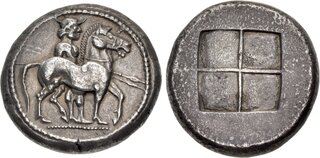 |
Match 5:


